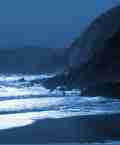

Carlingford Castle,
County Louth
Looking down from a rock above the medieval walled town, this striking fortress stands guard over the harbour and the narrow pass between the town and the lofty mountains of the Cooley Peninsula. Historical references to the castle are sparse, but on architectural grounds it was most likely begun around 1200, probably by Hugh de Lacy. King John stayed here for three days in 1210, and later that century the eastern side of the castle was remodelled.
The original fortification evidently consisted of a manysided curtain wall enclosing a roughly oval area around the summit of the rock. This survives around the western portion of the castle's courtyard, together with a flanking tower and the remains of a twin-towered gatehouse. Only portions of the northern gatehouse tower survive, but it is evident the gate towers flanked a surprisingly narrow entrance passage. The well-preserved square tower is noteworthy for the way its plan changes to a half-octagon on the upper levels. The massive cross-wall of the castle was probably added in 1262 when records in a pipe roll show substantial payments being made for stone, timber and lead for building works at Carlingford. At this time, much of the eastern section of the castle was also remodelled to create three-storey apartments and a great hall. A four-storey range was added in the 15th century; this is now ruined but has some interesting fireplaces and arcading. Carlingford appears to have remained in English hands during the post-medieval period. In 1596 Hugh O'Neill, Earl of Tyrone, tried to take the castle in a surprise attack. It was captured by Sir Henry Tichborne (Royalist) in 1642, surrendered to Lord Inchiquin (Royalist) in 1649 and delivered up to Sir Charles Coote (Cromwellian) the following year. It is likely Coote dismantled the castle, for it plays no further role in Irish history, though the town was used as a hospital station during the Williamite wars.Carlingford town. NGR: J 188120.
Click here Irish Castles to buy the newly reformatted book from Amazon.co.uk. The previous edition of Irish Castles is also still available from Amazon.co.uk.
